Feb 07, 2018
Recruitment and Retention: Overcoming the Rural EMS Dilemma
by Jenn Lukens
“When I was a young paramedic, I thought my career would take me to a big city where I could be a big chief of a big service. Now, I'm sitting here with a much more fascinating problem, and that's called rural America – rural EMS,” said Andy Gienapp.
Gienapp left his position as a field supervisor for Emergency Medical Services (EMS) in urban Tennessee to become the Director of the Wyoming Office of EMS in 2010. As a longtime paramedic, he has served in many leadership positions in the EMS field and with the U.S. Army. It wasn't until Gienapp moved to Wyoming that he experienced the shortage of EMS personnel as a growing problem for non-metro regions.
As the rural EMS workforce has decreased, the responsibilities and educational requirements have increased. No matter how low the call volume, ambulances still need to be fully equipped and personnel properly trained and ready to respond at a moment's notice. Limited funding, expanding coverage areas, and a cultural shift in volunteerism across generations have motivated EMS leaders to find new recruitment methods that attract more personnel and keep them as long as possible.
A Cultural Shift in Volunteerism
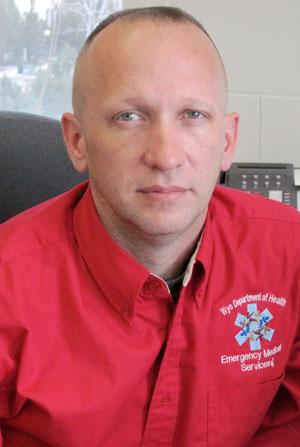
“Back in the day, it was really easy to start an ambulance service,” explained Gienapp of the 1960s and 70s, when EMS was just starting in rural America. “In most small towns, a bunch of folks came together, saw a need, and got some volunteers and training.” The rural population decline of the 1980s, social changes, and a change in skills needed heightened the competition for volunteers among EMS agencies.
As the average age of rural residents increases, many towns are relying on people in their 60s and 70s to manage EMS agencies. “EMS is being held together by an older generation who is very much connected to their neighbors [and who believe that being an EMS volunteer] is a way they can give back to their community,” stated Gienapp. “But younger generations simply are not connected that way.”
It's much easier to volunteer my time at a soup kitchen and work with the homeless population or a women's shelter than to wake up at three o'clock in the morning and do a transfer from a small hospital to a big hospital, which is a lot of what impacts EMS in rural America.
In addition to working longer hours, commuting further distances, and family responsibilities, younger people tend to look for volunteer options that are less time intensive. Gienapp explained, “It's much easier to volunteer my time at a soup kitchen and work with the homeless population or a women's shelter than to wake up at three o'clock in the morning and do a transfer from a small hospital to a big hospital, which is a lot of what impacts EMS in rural America.”
This “cultural shift,” requires a change in how EMS agencies recruit volunteers. The current “volunteer subsidy,” or the value of volunteer time, is estimated to equal a national average of $24.14 an hour, as of 2016. The recent loss of volunteers has motivated some agencies to move toward a mixed workforce structure, combining what paid employees the agency can afford with an ever-diminishing pool of volunteer EMTs, often offering hourly or per-call stipends as incentives. With most models moving in this direction, the uncompensated volunteer is growing rare.
Recruitment and Retention Tactic #1: Offer Stipends
Jeb Stuart Volunteer Rescue Squad of Stuart, Virginia began offering stipends to pay their volunteers per call in 2017. Funds from the county and a change in their billing methods have allowed them to provide stipends to cover up to 16 calls every two weeks or 32 calls a month.
Derek Wagner, the squad's 22-year-old captain, shares that monetary stipends like these are the ticket to attracting a younger generation. “Because their lives are so busy, money is important to someone fresh out of high school. And they are the ones we should be marketing to since there are some long nights of staying up 'til three or four in the morning. They can handle it a little better.”
Isolation Leads to Innovation in Nevada
Many EMS agencies that were once independently operated have merged with their local hospital, which often helps cover overhead costs. Being directly associated with a hospital has allowed Humboldt General Hospital EMS Rescue (HGH EMS Rescue) in Winnemucca, Nevada to have 25 full-time paid EMS employees and 25 quasi-volunteers. Located in a state that has one of the lowest usages of ambulance services, they make up for it by serving a large area of northern Nevada and the southern portion of Oregon.
HGH EMS Rescue Chief Sean Burke can attest that one of the biggest hindrances to their recruitment and retention efforts is the remoteness of their location. “Most of the industry in the area is either agriculture or mining, so if that's not your thing or your spouse's thing, it can be a difficult place to attract people to,” said Burke.
Despite their remoteness, HGH EMS Rescue has managed to recruit personnel from outside of the area. The purchase of a MedX AirOne helicopter and a specialized quad cab medium duty ambulance for interfacility transfers have been big draws for EMS personnel looking for the latest equipment and a new challenge.
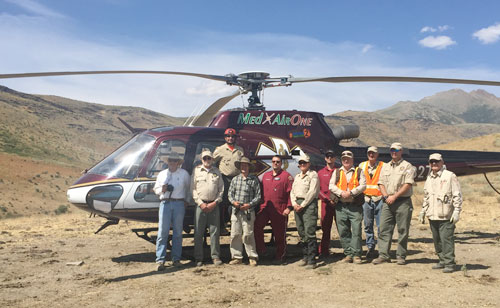
Because of the distances and the remote locations, we really expect and train our people to some pretty high standards…They are not wallflowers.
“We like to think we are not just the average grab-and-go ambulance service,” stated Burke. “Because of the distances and the remote locations, we really expect and train our people to some pretty high standards. We have a great medical director who is forward-leaning. Our guidelines are fairly cutting-edge and the ability to do more advanced paramedic skills, I think, is attractive to people who like this career path…They are not wallflowers.”
Burke applies his leadership experience in the U.S. Coast Guard and his Organizational Management master's degree to helping his team members excel, training them to lead a low-angle ropes rescue team, the wreck extrication crew, the county's Hazardous Materials Response Team (HAZMAT), or community EMT and CPR courses. “They become vested in the success of the organization that way,” said Burke. “I think that the added level of responsibility improves our ability to retain people.”
Accurate Promoting Takes Transparency
Across the nation, training requirements have increased to support the expectations for EMT. “Just like in big cities, the expectation in rural areas is that EMS is available anytime, for anything, anywhere,” added Gienapp. “But it's not just picking people up off the highways anymore who are in a wreck. It's not just…answering a call for a heart attack.” In more recent years, it has also meant being on stand-by for athletic and community events, responding to opioid overdoses, and distributing naloxone.
The number of training hours required varies depending on the certification level, but EMT course difficulty is generally compared to taking six to eight credits of college courses during a semester, which can easily turn into 16 to 20 hours of work a week.
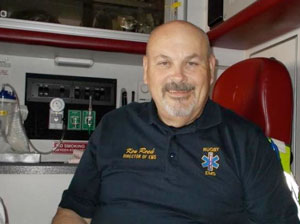
Ken Reed has served in EMS for 44 years and is currently the Director of the Rugby EMS, a service of the Heart of America Medical Center in northcentral North Dakota. He serves on the North Dakota EMS Advisory Council and has been a featured speaker at many EMS and health conferences across the state and nation. Interestingly, he also worked closely with Andy Gienapp in Tennessee before moving back to North Dakota. The two share similar ideas regarding the current state of EMS.
“EMT is a health career; it's not a simple program. It's two to three times the hours required for a certified nursing assistant, and you don't see any volunteer CNAs,” said Reed. “We are asking people to become healthcare professionals, essentially. The difference with EMS is that we are asking them to be undercompensated healthcare professionals.”
We are asking people to become healthcare professionals, essentially. The difference with EMS is that we are asking them to be undercompensated healthcare professionals.
In North Dakota, Reed has witnessed focused marketing efforts to promote EMT classes where many sign up, but only a few graduate. He believes it's largely due to how the classes are portrayed. “Often, [the requirements] get undersold to get people in the door. People, especially in the volunteer units, are recruited without having a full knowledge of everything that is entailed,” said Reed.
Instead of using the courses as an introduction to EMS, Reed suggested being forthright in communicating the amount of work, hours required, and the intensity of the call work. He suggests that bringing them on as driver or assistant first allows them to experience the environment and could then fuel their motivation to become an EMT. Whether being a part of a hospital or an independent agency, having an active presence on social media, newspapers, and other media outlets can help boost awareness of the requirements in becoming an EMT and service needs.
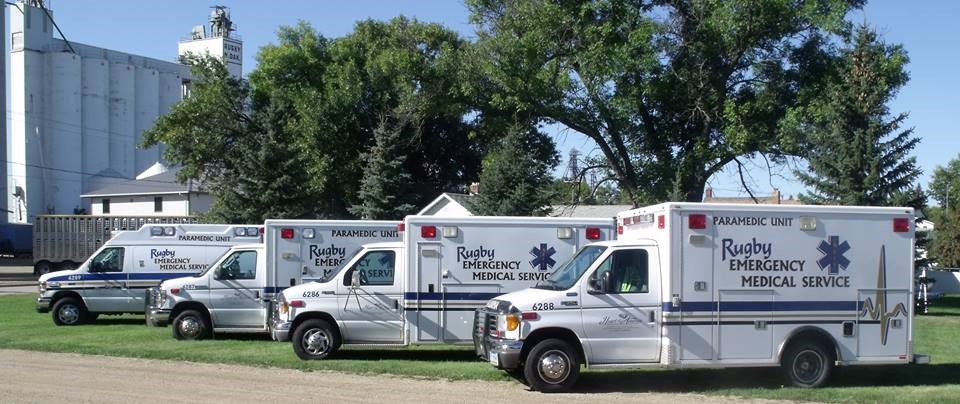
Change Starts at the Top
One of the main responsibilities of each State Office of EMS is to oversee the regulation of EMS personnel and license ambulance services. Although office directors are not held responsible for resolving workforce issues, Gienapp does what he can to help local agencies, meeting with leaders to offer assessments and trainings in partnership with an independent consulting firm.
One of the biggest areas in need of improvement, he noted, is with rural EMS management. In addition to budgeting, organization, people skills, and vision casting, being open to change is an essential characteristic for EMS chiefs looking to attract a younger generation. “A domineering presence that is resistant to change just does not play well with the millennial generation. They're not going to put up with it,” said Gienapp.
For newcomers to his crew, Reed takes special care in setting them up for success. He pairs them with experienced paramedics and EMTs who intentionally offer support until he or she reaches journeymen's status in their particular level of licensure. Reed thinks the mentorship has helped the retention rates of his crew. “The only two reasons I lose anybody, for the most part, is either they don't make probation or they go on to something bigger and better.”
Because of their increasingly demanding call schedule and expanding coverage area, EMS personnel may easily experience sleep deprivation, decreased productivity in their work, physical illness, and even mental/emotional strain. As the leader of his squad, Burke takes a proactive role in caring for the team's mental health.
“We see things that are pretty hard to look at sometimes,” said Burke. “We have folks on staff at Humboldt who are trained to perform interventions for these kinds of situations, so we make frequent use of that so that people aren't developing, at best, compassion fatigue or, at worst, PTSD.”
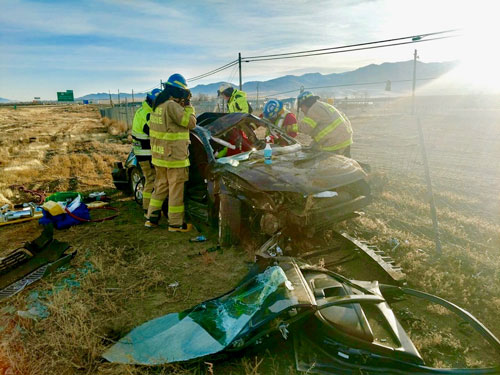
Recruitment and Retention Tactic #2: Involve Local Businesses
In North Dakota, Troy Scherr, Co-Owner of Sayler Implement of Wishek and Linton, offers his employees paid time off to take ambulance and fire calls. “EMT or firefighter – we need them,” said Scherr. “I wish I could be a firefighter myself, but by paying them, I'm trying to do my part to show my respect and support for their work in the community. As a business owner, it's the least I can do.”
New Jersey's Middlesex County Department of Public Safety and Health created rewards cards for volunteer firefighters and EMTs. The cards can be used in local businesses to receive discounts and benefits and were promoted by the Middlesex County Regional Chamber of Commerce. Although this model was developed in an urban area, it can be applied to rural communities.
Forming Educational Partnerships
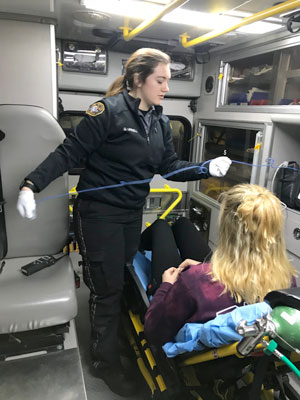
One of the challenges rural EMS faces in recruiting personnel is the abundance of programs that offer training courses. With limited budgets, traveling to so many schools for recruitment efforts is not a possibility for many agencies.
Humboldt capitalized on an opportunity to partner with Great Basin College, located 200 miles from Winnemucca. Great Basin allows HGH EMS Rescue to host their EMT classes for Humboldt locals at their station via teleconference. In turn, HGH EMS Rescue offers placement for Great Basin's paramedic students needing clinical experience. HGH EMS Rescue has hired three out of the six paramedics who graduated from the Great Basin College Emergency Medical Services Program this past year.
Over the past four years, HGH EMS Rescue has also run a youth pipeline program. Qualifying high school students can take a full year of EMT classes for credit at no cost. HGH EMS Rescue has consistently hired at least one student from every graduating class. “I think it helps they are from the local community; they have more of a connection with the community and more of a sense of urgency in helping their neighbors,” said Burke.
The ability to attract bright young candidates into our service – I don't know how you put a price on that.
HGH EMS Rescue pays for a fulltime education coordinator who manages and teaches the pipeline students. While Burke admits that they don't get a 100% return on investment, “The ability to attract bright young candidates into our service – I don't know how you put a price on that. We've never sat down and tried to quantify that, but I guess, if you compare that to hiring a recruiter and advertising, I have to think we are doing okay.”
Recruitment and Retention Tactic #3: Tax Credits Create Incentive
Since 2006, the Oregon Office of Rural Health (ORH) has awarded $250 in personal income tax credit to eligible EMS providers in rural communities as a gesture of appreciation and incentive to recruit volunteers. Another one of ORH's initiatives, the HERO Campaign, awards up to $300 of donated funds to EMS volunteers or EMS agencies to help with educational and training expenses.
Robert Duehmig, Deputy Director of ORH, commented, “EMS providers are an important part of our healthcare workforce. We need to ensure that we have enough of them to meet our rural communities' needs. That means [SORHs] need to be proactive in our efforts to help rural communities recruit and retain an EMS workforce.”
Engaging at All Levels
In addition to his responsibilities in Wyoming, Gienapp serves as a board member of the National Association of State EMS Officials (NASEMSO), Committee Chair of its Rural EMS Committee, and Co-Chair of the Joint Committee on Rural Emergency Care (JCREC). “The rural EMS cause is a drum that I'm often beating,” Gienapp stated. Fortunately, Gienapp has found like-minded individuals on the national, state, and local level with the same concerns for rural EMS workforce issues. “People are starting to wake up and pay attention,” he said.
Gienapp is also a technical expert panelist for the EMS Agenda 2050, a national collaborative effort funded by the National Highway Traffic Safety Administration (NHTSA) Office of EMS, to propose EMS advancement opportunities over the next three decades. Alongside of that effort, JCREC is working with Kevin McGinnis, the original author of the Rural and Frontier EMS Agenda for the Future, to adapt the report into a modern, tactical version that will include recruitment and retention strategies.
We now have what we didn't have 40 years ago: a lot of successes and failures and data and information, but that means that people within the states are going to have to engage at all levels and be willing to have some really hard conversations.
Gienapp suggests that the workforce problems rural EMS is experiencing are the result of a system designed for different times and will take a group effort to change its direction. “We all – state partnership between State EMS Offices, elected officials at local levels, ambulance services themselves, patients participating in the system – have to get very deliberate about EMS design,” said Gienapp. “We now have what we didn't have 40 years ago: a lot of successes and failures and data and information, but that means that people within the states are going to have to engage at all levels and be willing to have some really hard conversations.”
Recruitment and Retention Tactic #4: Participate in the Dialogue
Attend an event. The National Rural EMS and Care Conference will take place April 24-25 this year in Tucson, Arizona. The event is a platform for NASEMSO, JCREC, and the National Organization of State Offices of Rural Health (NOSORH) to highlight recruitment and retention concerns, success stories, and encourage change from a local level. Those involved with rural EMS and healthcare, along with governing bodies, will be present.
Join the conversation in your state. For example, in New Jersey, public hearings are being held by the newly formed Task Force on Volunteer Emergency Service Recruitment and Retention to listen to opinions and recommendations from EMS volunteers. Contact your State EMS Office or your State Office of Rural Health to propose your own ideas or find out more information.
Additional Resources:
- RHIhub's Rural Emergency Medical Services (EMS) and Trauma Topic Guide provides a thorough overview of rural EMS, including information on recruitment and retention.
- The National Registry of Emergency Medical Technicians maps display EMS personnel and licensing data by state.
- The article How to Successfully Recruit Volunteers shares 10 ideas to increase EMS workforce.
- NASEMSO's Fatigue in EMS offers resources and evidence-based guidelines to help mitigate the effects of fatigue.
- Prehospital Emergency Medical Services Personnel in Rural Areas (2015) published results from a workforce study conducted in nine states.
- National Emergency Medical Services Workforce Data Definitions (2013) was created to facilitate data-driven EMS workforce planning and research.
- The EMS Workforce Agenda for the Future (2011) provides a vision and suggestions to help ensure a robust rural EMS workforce in the 21st
- JCREC's Improving Access to EMS and Health Care in Rural Communities: A Strategic Plan (2010) provides an evaluation of EMS workforce and steps for the future.
- Volunteerism in Rural EMS: Report from the Field (2010) discusses volunteer characteristics and outlines needed changes.
